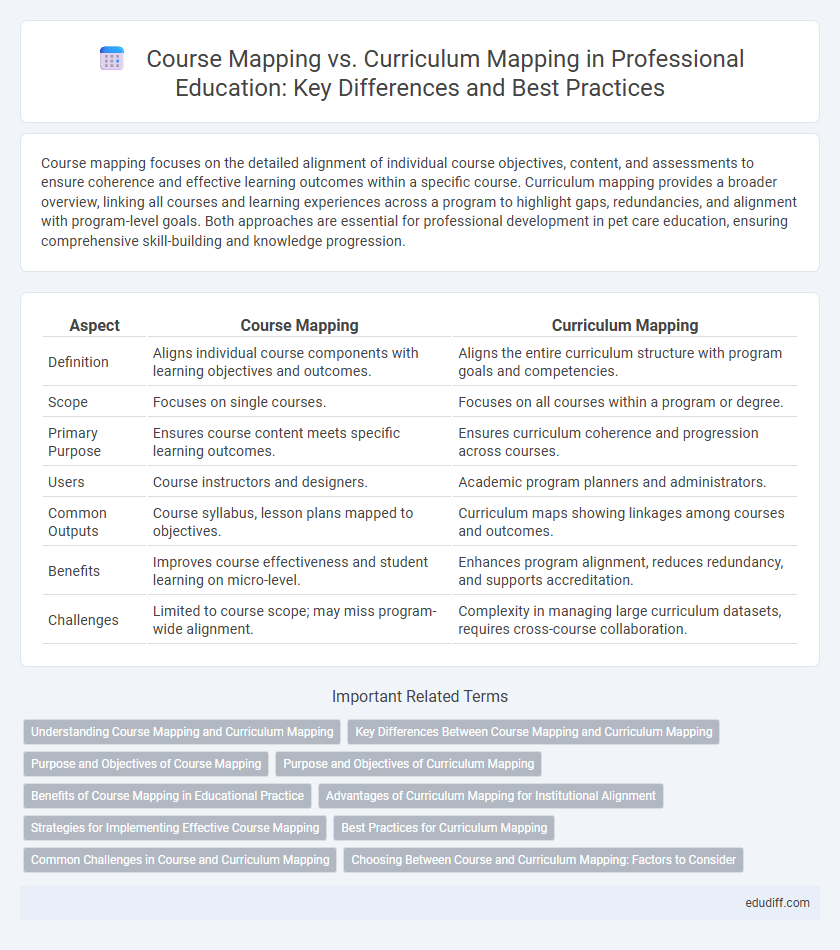Course mapping focuses on the detailed alignment of individual course objectives, content, and assessments to ensure coherence and effective learning outcomes within a specific course. Curriculum mapping provides a broader overview, linking all courses and learning experiences across a program to highlight gaps, redundancies, and alignment with program-level goals. Both approaches are essential for professional development in pet care education, ensuring comprehensive skill-building and knowledge progression.
Table of Comparison
| Aspect | Course Mapping | Curriculum Mapping |
|---|---|---|
| Definition | Aligns individual course components with learning objectives and outcomes. | Aligns the entire curriculum structure with program goals and competencies. |
| Scope | Focuses on single courses. | Focuses on all courses within a program or degree. |
| Primary Purpose | Ensures course content meets specific learning outcomes. | Ensures curriculum coherence and progression across courses. |
| Users | Course instructors and designers. | Academic program planners and administrators. |
| Common Outputs | Course syllabus, lesson plans mapped to objectives. | Curriculum maps showing linkages among courses and outcomes. |
| Benefits | Improves course effectiveness and student learning on micro-level. | Enhances program alignment, reduces redundancy, and supports accreditation. |
| Challenges | Limited to course scope; may miss program-wide alignment. | Complexity in managing large curriculum datasets, requires cross-course collaboration. |
Understanding Course Mapping and Curriculum Mapping
Course mapping involves aligning individual course objectives, content, and assessments with specific learning outcomes to ensure coherent instruction and measurable student progress. Curriculum mapping takes a broader approach by connecting sequences of courses across an entire program to overarching institutional goals and accreditation standards. Understanding the distinctions helps educators design effective educational pathways and maintain alignment with academic quality benchmarks.
Key Differences Between Course Mapping and Curriculum Mapping
Course mapping focuses on aligning specific learning objectives, assessments, and instructional activities within a single course to ensure coherence and targeted skill development. Curriculum mapping spans the entire educational program, tracking where and how key competencies and standards are addressed across multiple courses and semesters. The key difference lies in the scope: course mapping manages detailed content delivery within one class, while curriculum mapping oversees the integration and progression of learning outcomes throughout the full academic program.
Purpose and Objectives of Course Mapping
Course mapping focuses on aligning specific course content, learning outcomes, and assessments with program goals to ensure coherence and targeted skill development. Its purpose is to identify gaps or redundancies within individual courses and optimize instructional design for effective student learning. This process supports curriculum quality by ensuring each course contributes directly to the overall educational objectives and accreditation standards.
Purpose and Objectives of Curriculum Mapping
Curriculum mapping aligns learning objectives with instructional content and assessment methods to ensure educational consistency and coherence across all courses in a program. It facilitates identifying gaps, redundancies, and opportunities for skill development, promoting continuous curriculum improvement. By providing a transparent framework, curriculum mapping supports accreditation processes and enhances student learning outcomes through targeted instructional strategies.
Benefits of Course Mapping in Educational Practice
Course mapping enhances educational practice by aligning specific learning objectives with assessments and instructional activities, enabling precise tracking of student progress. It supports targeted curriculum adjustments through detailed analysis of individual courses, fostering continuous improvement in teaching effectiveness. This granular approach promotes consistency in course delivery and ensures that all key competencies are adequately addressed within the academic program.
Advantages of Curriculum Mapping for Institutional Alignment
Curriculum mapping enhances institutional alignment by providing a comprehensive overview of course content, learning outcomes, and assessment methods across all programs, ensuring consistency and coherence in educational delivery. It facilitates collaboration among faculty members, promotes the identification of gaps and redundancies, and supports continuous curriculum improvement tied to institutional goals. By aligning curriculum components with accreditation standards and stakeholder expectations, curriculum mapping strengthens academic quality and accountability.
Strategies for Implementing Effective Course Mapping
Effective course mapping involves aligning course objectives with program outcomes, ensuring coherence between lessons, assessments, and learning milestones. Utilizing detailed criteria matrices helps educators identify content gaps and overlaps, facilitating targeted improvements in course design. Integrating technology platforms enables continuous monitoring and data-driven adjustments to enhance curriculum alignment and student achievement.
Best Practices for Curriculum Mapping
Curriculum mapping involves aligning learning objectives, assessments, and instructional strategies across an entire program to ensure cohesive educational experiences and meet accreditation standards. Best practices for curriculum mapping include engaging faculty collaboration, using data-driven analysis to identify content gaps and redundancies, and regularly updating maps to reflect evolving academic goals and industry demands. Effective curriculum mapping improves student learning outcomes by fostering transparent curriculum alignment and facilitating continuous program improvement.
Common Challenges in Course and Curriculum Mapping
Common challenges in course and curriculum mapping include ensuring alignment between learning objectives and assessment methods, managing inconsistencies across multiple instructors, and maintaining up-to-date documentation amidst evolving academic standards. The complexity of integrating interdisciplinary content often leads to gaps or overlaps that hinder cohesive student learning pathways. Effective collaboration and continuous review processes are essential to address these issues and enhance curriculum coherence.
Choosing Between Course and Curriculum Mapping: Factors to Consider
Choosing between course mapping and curriculum mapping depends on the scope and objectives of academic planning. Course mapping focuses on aligning specific course content, learning outcomes, and assessments, making it ideal for detailed instructional design and immediate course improvements. Curriculum mapping provides an overarching view of program-level goals, competencies, and coherence across multiple courses, essential for ensuring alignment with institutional standards and long-term educational strategies.
Course Mapping vs Curriculum Mapping Infographic

 edudiff.com
edudiff.com